Mad Hedge Biotech and Healthcare Letter
December 24, 2024
Fiat Lux
Featured Trade:
(THE LAB RESULTS ARE IN)
(GILD), (TSLA), (WVE), (EDIT), (CRSP), (LLY), (NVO), (WMT), (CVS), (CCCC), (RHHBY)

Mad Hedge Biotech and Healthcare Letter
December 24, 2024
Fiat Lux
Featured Trade:
(THE LAB RESULTS ARE IN)
(GILD), (TSLA), (WVE), (EDIT), (CRSP), (LLY), (NVO), (WMT), (CVS), (CCCC), (RHHBY)

I found myself gridlocked in Bay Area traffic a few days ago, inching past Gilead's (GILD) sprawling Foster City headquarters, when my phone lit up with a call from an old friend at Goldman.
“Alright, tell me—what’s the real story with biotech this year?” she asked, her tone hovering somewhere between curiosity and exasperation. “Half my portfolio feels like a masterstroke, the other half... well, let’s just say it’s testing my patience.”
As I watched a Tesla (TSLA) weave through traffic like it was auditioning for a Fast & Furious reboot, I smiled.
Biotech has always been a bit of a high-stakes chess game—brilliance in one corner, chaos in another, and always a few surprises lurking behind the next move.
“Let me break it down for you,” I said, steering the conversation as carefully as I did my car through the bumper-to-bumper maze.
First, the winners are crushing it, and I mean crushing it. Gilead (GILD) finally cracked the code on HIV treatment, developing what's essentially a vaccine that doesn't require popping pills like they're Tic Tacs.
My contacts in clinical development tell me the Phase 3 data in cisgender women is nothing short of spectacular. With a $6 billion annual market potential by 2028, this isn't just another incremental advance - it's the kind of breakthrough that makes everyone in biotech salivate.
Then there's Wave Life Sciences (WVE) and their RNA editing technology. Remember when we thought CRISPR was the only game in town? Well, Wave just showed us there's more than one way to edit a gene.
Their liver-targeting therapy is the first successful RNA editing in humans - think of it as spell-check for your DNA, but reversible. The market's currently at $1.1 billion, but with 35% CAGR through 2030, this train is just leaving the station.
Speaking of trains leaving stations, molecular glue developers like C4 Therapeutics (CCCC) are watching Big Pharma back up the Brink's truck.
We're talking $8 billion in licensing deals this year alone. After all, when Roche (RHHBY) drops $300 million upfront - not milestone payments, mind you, but cold hard cash - you know they've seen something special in the data room.
But here's where it gets interesting, and I had to pull over at this point in the conversation because my friend wasn't going to like what came next.
CRISPR stocks? Down 20%. Editas (EDIT) and CRISPR Therapeutics (CRSP) are learning that revolutionary science doesn't always translate to revolutionary returns.
My friend Janet at the Fed might be talking about higher rates, but these companies are bleeding cash faster than a Silicon Valley startup's WeWork budget.
The obesity market? Unless your name is Eli Lilly (LLY) or Novo Nordisk (NVO), you're probably not having a great time.
Only three startups cleared $100 million in funding this year. In biotech terms, that's like trying to build a house with pocket change.
The global market's sitting at $4.1 billion, but it's more crowded than a San Francisco coffee shop during a tech conference.
And don't get me started on Walmart (WMT) and CVS (CVS) trying to play doctor. They thought they could disrupt traditional healthcare with their “get your physical next to the garden tools” model.
The result? A combined loss of $250 million and a wave of clinic closures.
The lesson here is clear: just because you can sell lightbulbs and Band-Aids in the same aisle doesn’t mean you should try to diagnose strep throat next to the automotive department.
A kid in a modded Subaru WRX cut me off as I wrapped up the call, but I left my friend with this: In biotech, timing is everything.
Gilead and Wave are showing us that patience pays off when the science is solid. Meanwhile, CRISPR stocks remind us that even the most promising technology needs good timing and deep pockets.
So, watch those clinical trial results like a hawk, and keep an eye on where the venture money's flowing.
But most importantly, remember what my old mentor used to say: "In biotech, you're not just betting on the science - you're betting on the scientist, the CFO, and sometimes, just sometimes, on whether people are ready to get their flu shot next to the garden center."
Now, where's that highway patrol when you need them?
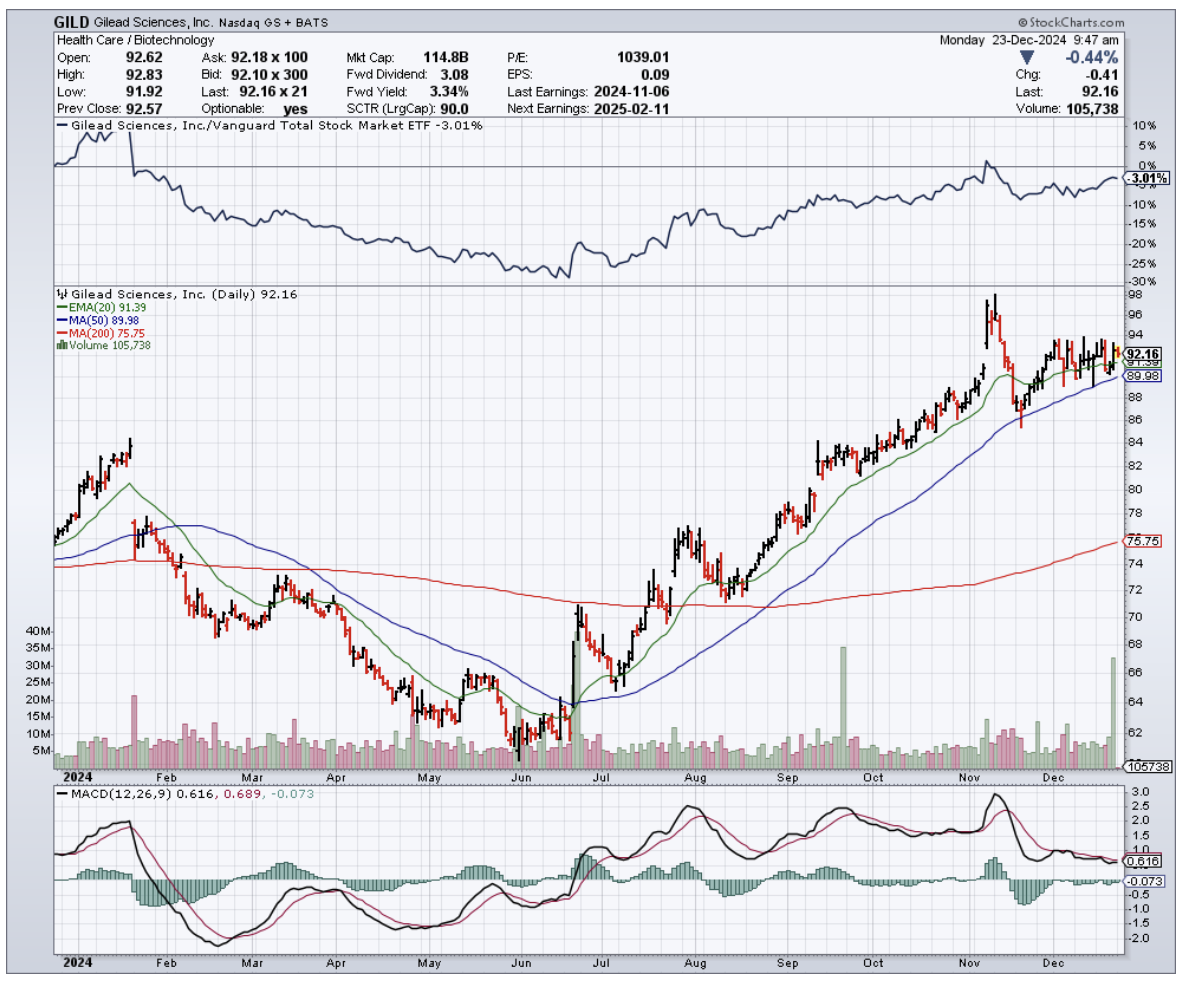
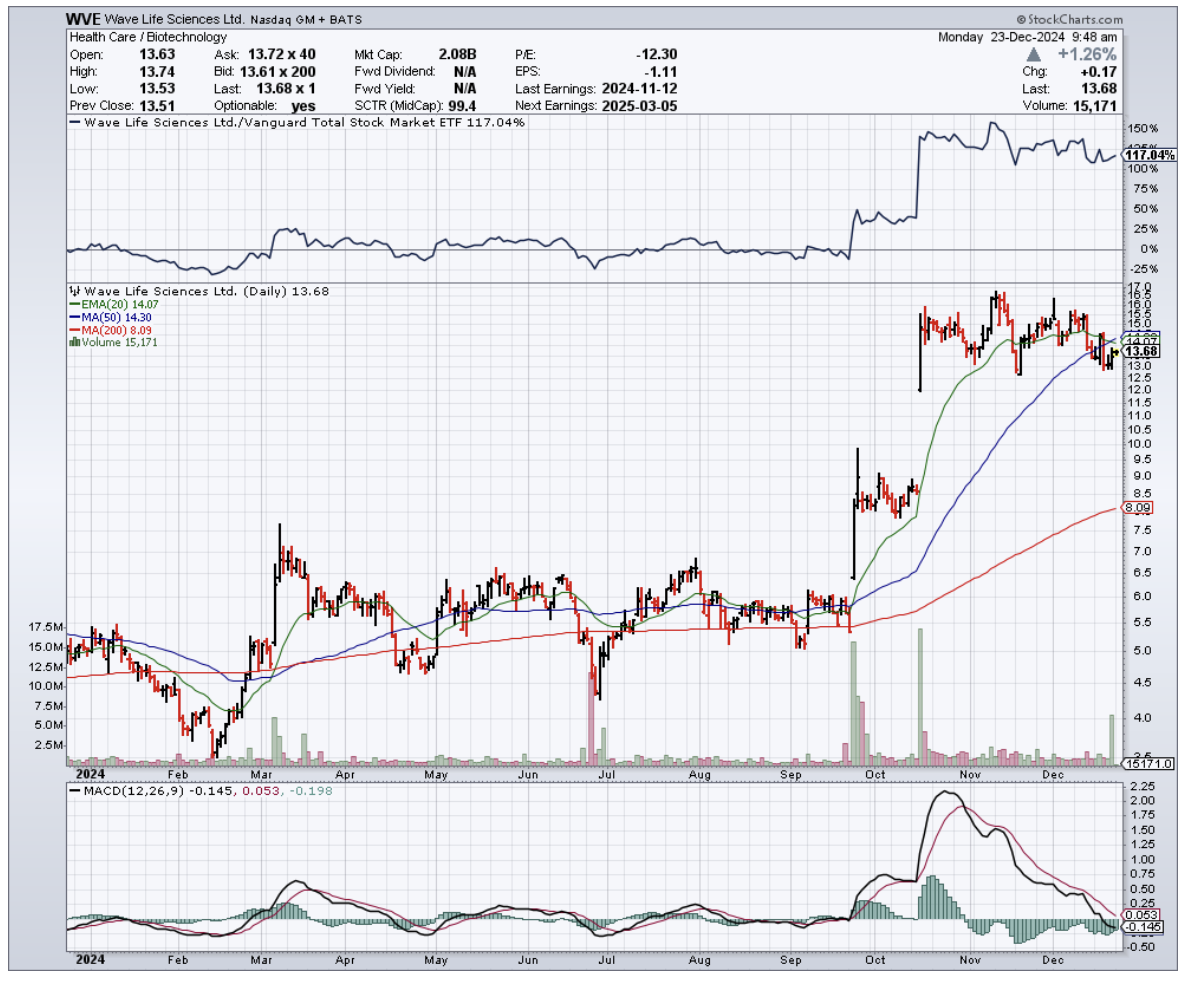
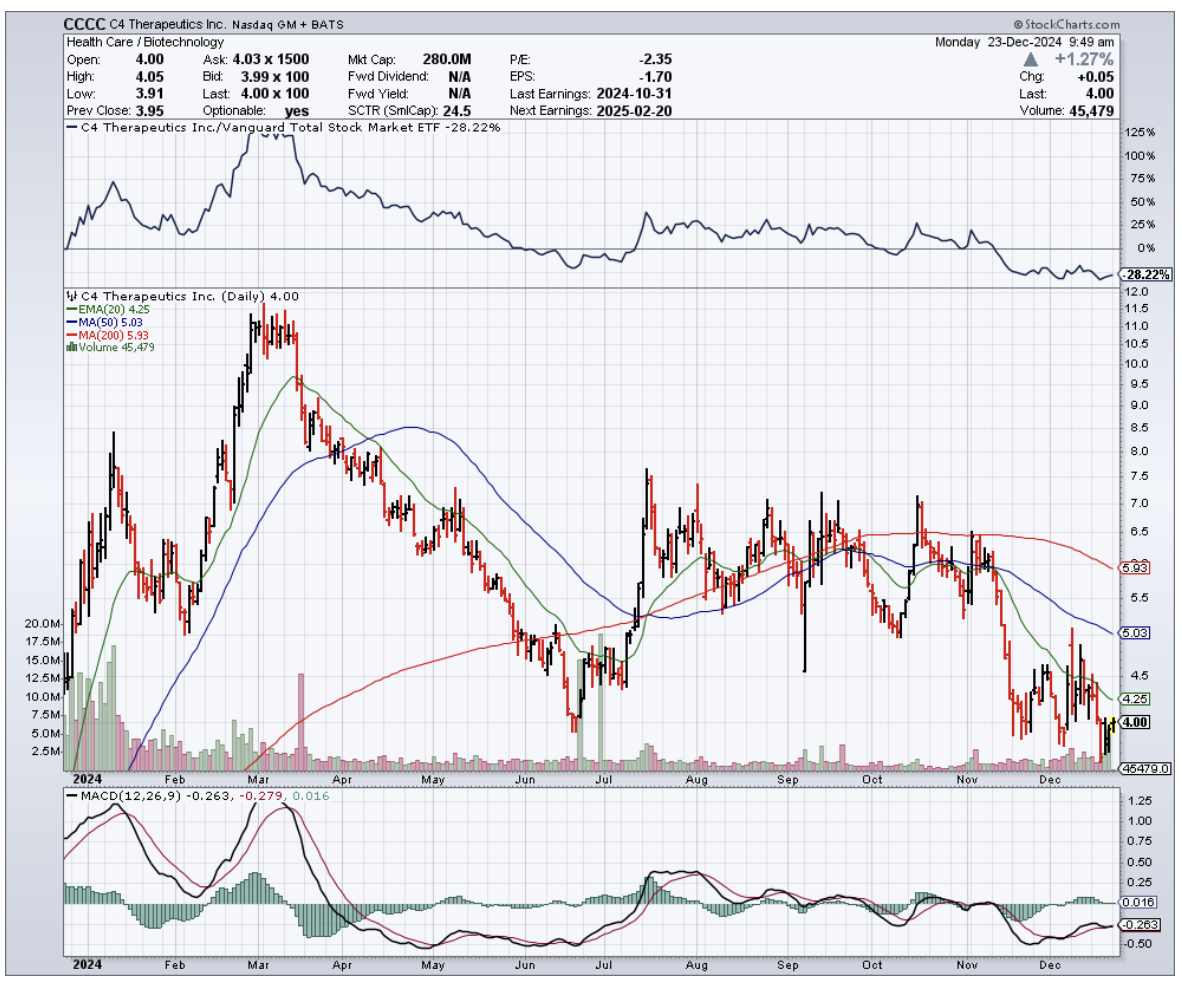
Mad Hedge Biotech and Healthcare Letter
December 3, 2024
Fiat Lux
Featured Trade:
(EYE SPY THE NEXT BIG THING)
(LCTX), (RHHBY), (ALPMY), (ADVM), (EDIT), (RGNX)

Mad Hedge Biotech and Healthcare Letter
June 18, 2024
Fiat Lux
Featured Trade:
(PHARMAGEDDON AVERTED)
(ILMN), (NVTAQ), (NTRA), (GH), (EXAS), (TMO), (QGEN), (NVS), (RHHBY), (AZN), (CRSP), (EDIT), (FATE)

For far too long, we've been playing a dangerous game of biotech roulette - throwing our hard-earned dough at stocks solely based on who's peddling the latest drugs and vaccines to the biggest crowds.
We tiptoe around those dreaded "patent cliffs", living in fear of the moment our cash cows turn into generic, discount-bin duds overnight.
As I've loudly proclaimed before, Big Pharma is fundamentally a tightrope act - milking those lucrative exclusives for all they're worth while bracing for the inevitable day those monopolies go kaput.
It's an anxiety-inducing cycle, one that's been running the show for decades.
But enough is enough. It's high time we tossed that musty old playbook straight into the trash. Why? Because the reign of Pharma's legacy model is fading faster than my hairline.
A new revolutionary force is taking over – personalized medicine.
Don't kid yourselves, this tectonic shift is the real deal. We're witnessing a paradigm upheaval in how drugs are developed and treatments are administered.
Advanced, genetically-tailored therapies are muscling their way to the frontlines, employing each patient's unique DNA blueprint to craft bespoke care strategies like never before.
Leading this charge are gene sequencing pioneers like Illumina (ILMN), equipping healthcare with bleeding-edge tech for genetic profiling and research.
Companies like Invitae (NVTAQ) and Natera (NTRA) are making genetic intel accessible and actionable for diagnosing and treating inherited nightmares like cancer and heart disease. This isn't a drill, people. It’s the new reality.
But the innovation train doesn't stop there. Guardant Health (GH) is upping the ante with its non-invasive blood tests that capture tumor genetic data, allowing physicians to map treatment plans without those pesky, invasive procedures.
And let's hear it for Exact Sciences (EXAS), championing molecular diagnostics to laser-focus cancer regimens based on each person's biological fingerprint.
Speaking of cancer, we'd be remiss not to spotlight the game-changing progress happening on the personalized medicine front.
At the latest American Society of Clinical Oncology shindig, the best oncology minds showcased their latest advancements in tailored treatments.
Get this – over the last four years, over a third of the FDA's new drug approvals were personalized meds. With the White House doubling down, those numbers are only going up.
Obviously, personalized medicine is this century's gold rush. In fact, a global biopharma race is already underway, and everyone’s practically frothing at the mouth.
After all, this half-trillion-dollar market is barreling towards the $1 trillion mark by 2031.
And in this blossoming field, outfits like Thermo Fisher (TMO) and Qiagen (QGEN) are indispensable, provisioning crucial tools and services.
Thermo covers the full genetic research and diagnostics gamut, while Qiagen specializes in sample prep and molecular testing – two linchpins for delivering personalized therapies.
But it's not just the upstart trailblazers making waves. Biotech titans like Novartis (NVS), Roche (RHHBY), and AstraZeneca (AZN) are going knees-deep into advanced, commercially-viable personalized treatments – especially in oncology, where understanding Individual genetic mutations can literally mean life or death.
Let's pour one out for the real pioneers here, too – groundbreakers like CRISPR Therapeutics (CRSP), Editas Medicine (EDIT), and Fate Therapeutics (FATE).
These mavericks are lighting up the gene editing and cell therapy arenas, hand-crafting hyper-personalized treatments that smite genetic diseases at the source.
Now, for those of you eagerly wondering where to splash your investment cash, I suggest you don't fall into the trap of banking solely on the next patented "winner" therapy.
Those old-school patent monopolies that once ruled the roost? Their significance is waning rapidly.
With the flurry of personalization tech out there, it's a Wild West – one company churns out a new treatment, another can swiftly follow suit.
Patent feuds and skyrocketing costs loom on the horizon like storm clouds. The gravy train of eternal patent profits is running out of steam.
But make no mistake, this arms race isn't cooling off anytime soon. The battleground's scope is simply shifting. It's no longer just about formulating the latest miracle drug – it's about delivering unbeatable services and customer experiences.
Because here's the cold hard truth – the biggest roadblock to getting these revolutionary therapies to patients is obtaining all the genetic data and personal insights needed to make it happen.
Healthcare providers are going to need to invest heavily in new data management systems, training, and education just to keep pace with these rapidly evolving personalized meds.
The pharma players that thrive? They're the ones going beyond prioritizing drug development to obsessing over best-in-class customer service and care delivery.
They'll cement customer loyalty, forge lasting partnerships – and in doing so, actualize personalized medicine's boundary-shattering promise. Those are the winners I'm betting big on.
So wake up and smell the coff-gene. The personalized biotech goldrush is kicking into high gear.
And those wise enough to stake an early claim? Well, let's just say they'll be dishing out more than genetics-guided therapy – they'll be minting a new generation of biotech fortunes.
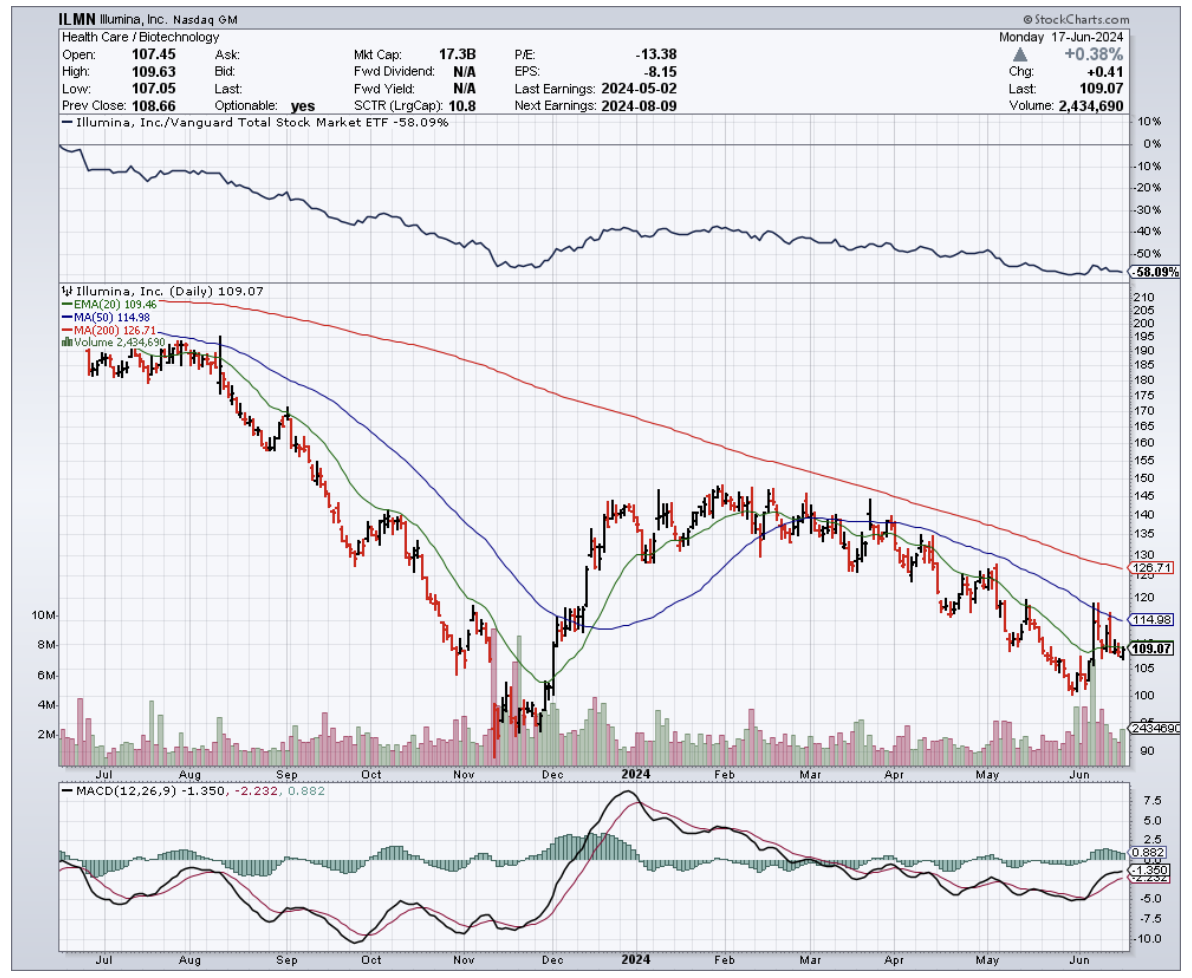
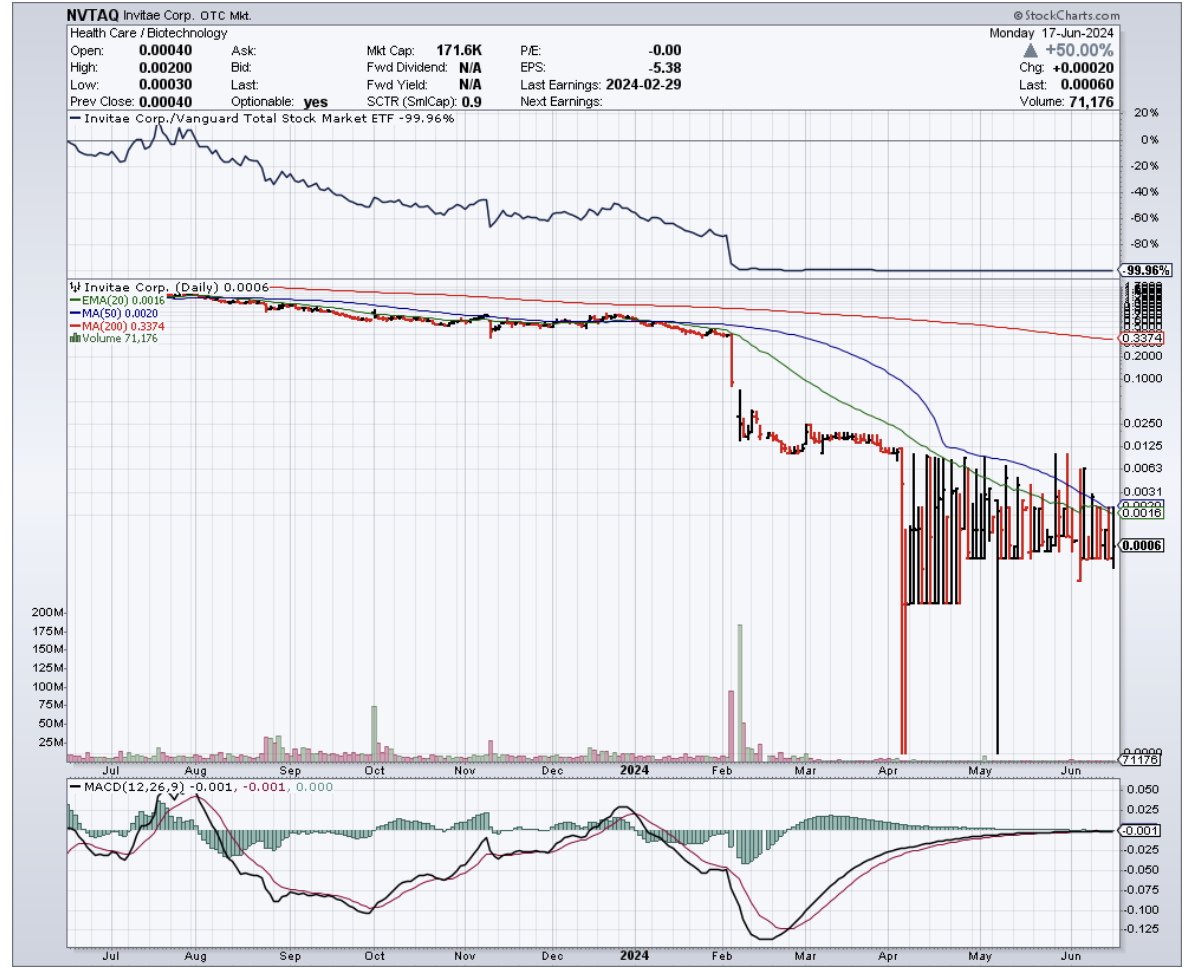
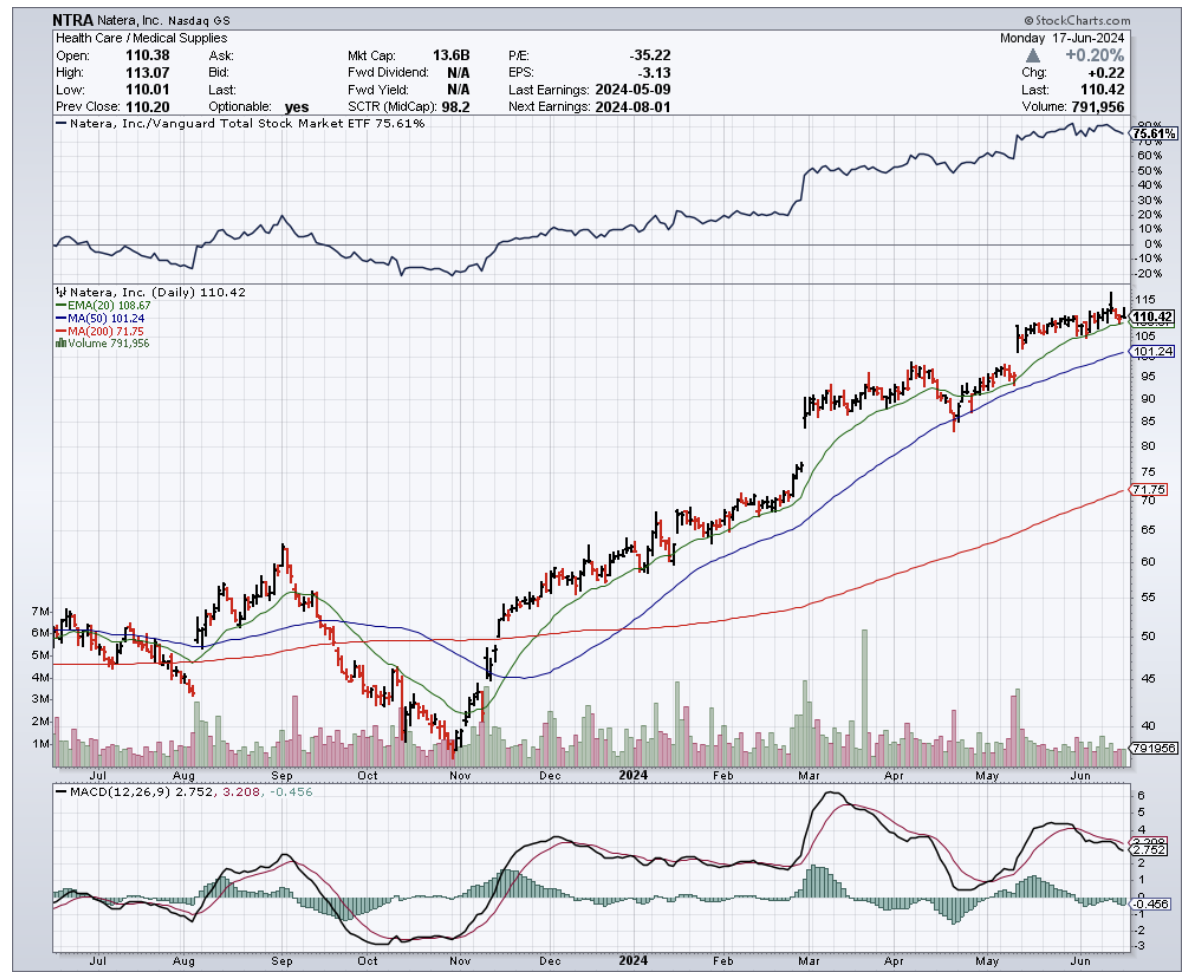
Mad Hedge Biotech and Healthcare Letter
December 14, 2023
Fiat Lux
Featured Trade:
(EDITING YOUR PORTFOLIO)
(CRSP), (VRTX), (BLUE), (BEAM), (CRBU), (EDIT), (NTLA), (PRME), (VERV), (LLY), (REGN)

In the world of biotechnology, the buzz these days is all about gene editing – a frontier that’s moving at warp speed.
While the journey from sequencing the first human genome took a staggering 13 years, companies like CRISPR Therapeutics (CRSP) have sped up the process, bringing their revolutionary "molecular scissors" concept to market in a mere decade.
It's a thrilling time for investors, with the potential for staggering returns, but the path is littered with clinical and regulatory landmines. This turns choosing the best stocks to put your money into a tricky challenge.
Recently, the FDA gave the green light to two groundbreaking gene therapies for sickle cell disease, developed by Vertex Pharmaceuticals (VRTX) in collaboration with CRISPR Therapeutics and by Bluebird Bio (BLUE).
This disease, predominantly affecting African-American communities in the U.S., has been a target for medical advancement for years.
While the approval is a landmark, it's not without its tremors. Bluebird Bio's stock took a nosedive by 33.9%, triggered by the FDA’s warning label about potential cancer risks linked to their treatment.
In contrast, the treatment by Vertex and CRISPR dodged such warnings, possibly giving it an edge in the eyes of prescribing doctors.
And then there’s the money side of things. Bluebird Bio missed out on a priority review voucher from the FDA, which they were hoping to sell to Novartis for a cool $103 million. That's a tough break.
Meanwhile, the Vertex and CRISPR therapy, now known as Casgevy, boasts the honor of being the first FDA-approved drug using the trailblazing Crispr/Cas9 technology. It's a Nobel Prize-winning innovation that's finally reaching the patients it promises to help.
The approvals of Casgevy and Bluebird Bio’s Lyfgenia, which arrived earlier than expected, mark a significant moment for patients with sickle cell disease.
Although priced in the millions, these treatments offer a potential one-time cure, replacing the traditional, complex regimens. Unfortunately, they are not without their challenges, involving intensive procedures, lengthy hospital stays, and chemotherapy.
This brings us to the investment side of things.
The gene-editing arena is brimming with potential, but it's akin to navigating a labyrinth. With no specific exchange-traded funds (ETFs) focusing solely on gene editing stocks, investors might feel like they're trying to find their way in the dark.
However, a diversified approach could be the lantern in this darkness.
Companies like Beam Therapeutics (BEAM), Caribou Biosciences (CRBU), Editas Medicine (EDIT), Intellia Therapeutics (NTLA), Prime Medicine (PRME), and Verve Therapeutics (VERV) are some of the key players in this space, each with its unique technological platform.
But it's not just the pure-play gene editors that are worth your attention. Giants like Eli Lilly (LLY), Regeneron Pharmaceuticals (REGN), and Vertex Pharmaceuticals have thrown their hats into the ring, making substantial investments in gene editing.
So, how should you play this? If it were my money, I'd spread it around.
Put a chunk in leaders like CRISPR and Intellia. Then, combine these with established players like Eli Lilly, Regeneron, and Vertex to provide a safety net, balancing out the inherent risks of this high-stakes biotech game.
On the other hand, companies like Beam and Verve, representing the next wave of this technology, should not be overlooked, though perhaps with a more conservative stake.
And here's a little hedge for you: keep an eye on smaller players like Caribou Biosciences and Editas Medicine. In this high-stakes game, they could be your ace in the hole.
The gene-editing industry is a roller coaster of innovation, risk, and potential. It's a sector where fortunes can be made and lost in the blink of an eye.
For the savvy investor, a diversified, strategic approach, blending the bold with the stable, could be the key to unlocking the vast potential of this exciting field.
Remember, as with any investment, the key is not just in choosing the right horses but knowing how to spread your bets across the race.

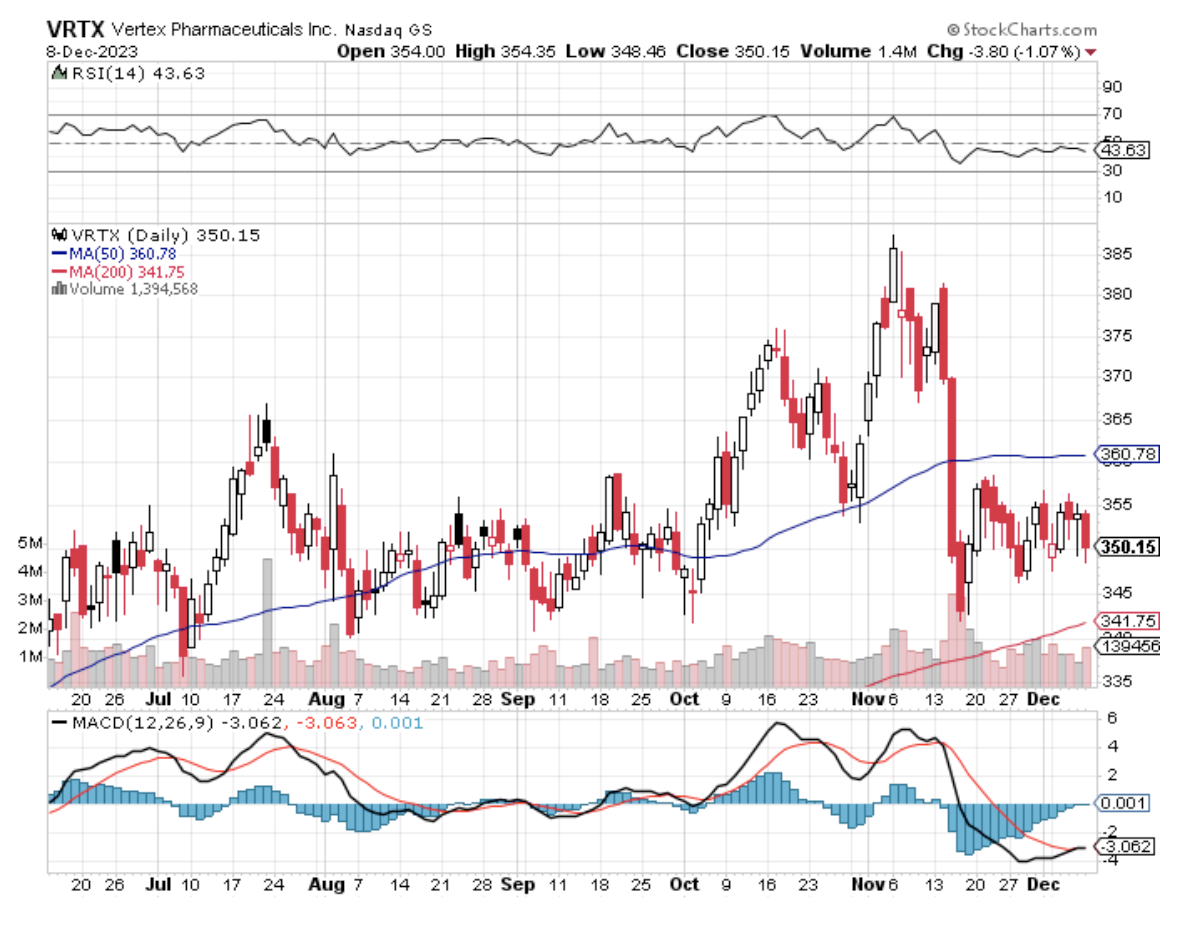
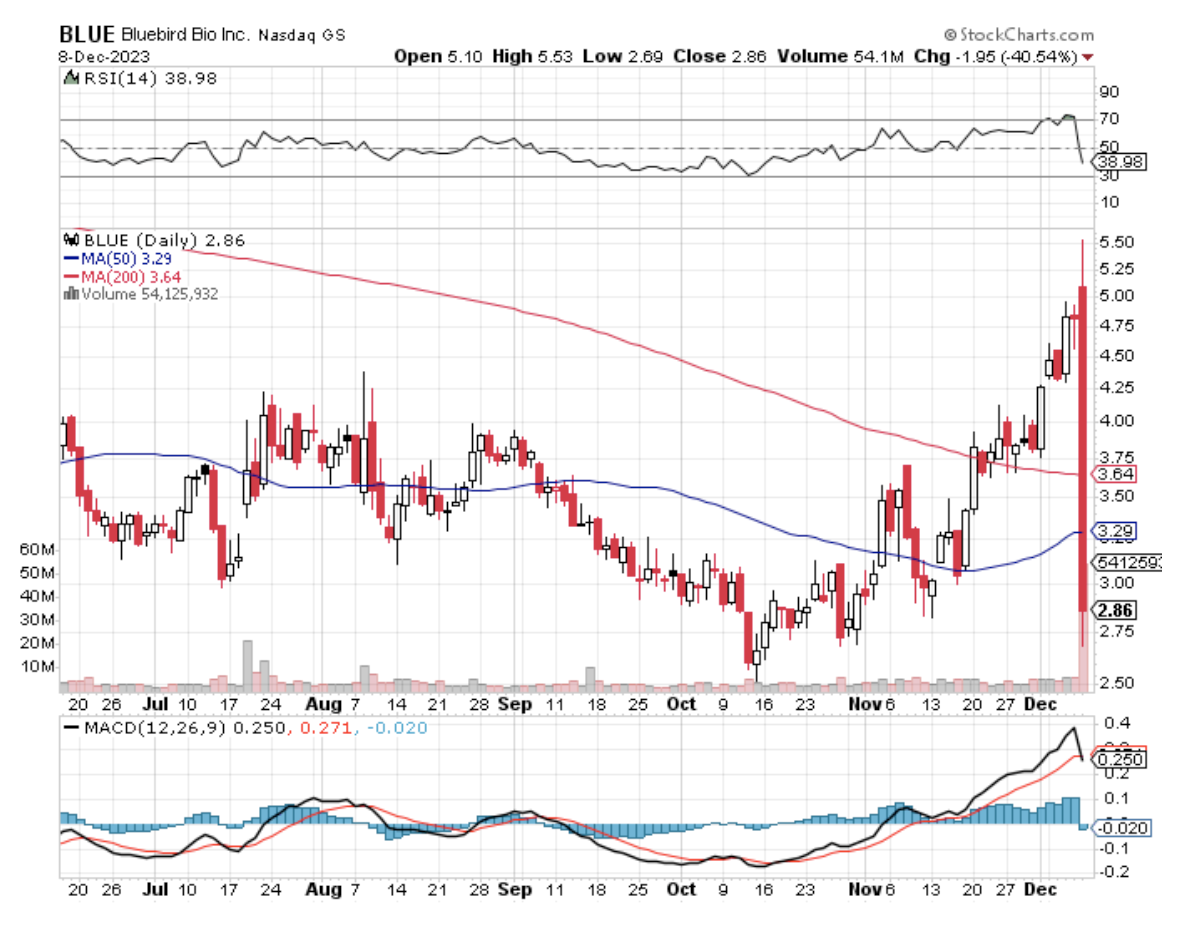
Mad Hedge Biotech and Healthcare Letter
February 23, 2023
Fiat Lux
Featured Trade:
(BATTLE FOR GENE THERAPY SUPREMACY)
(CRSP), (NVS), (BIIB), (BLUE), (VYGR), (GBIO), (SIOX), (NTLA), (EDIT), (VRTX), (PRIME), (BEAM)

Gene therapy is arguably one of the most fascinating and revolutionary fields in the healthcare and biotechnology industry.
A significant reason for the excitement behind gene therapy is that it provides the possibility of “functional cures,” such as “one-and-done treatments,” for patients. It’s also why these therapies are some of the most costly on the market.
For example, Zolgensma from Novartis (NVS), which focuses on treating spinal muscular atrophy in infants, has a whopping $2 million-plus price tag. Despite that, it’s considered the best option.
For context, its counterpart, Spinraza from Biogen (BIIB), costs roughly $750,000 in the first year of treatment. Unlike Zolgensma, Spinraza needs to be administered four times each year. After the first treatment, patients would need to pay $350,000 per annum. By the fifth year, Spinraza has surpassed the treatment cost of Zolgensma.
Despite its incredible potential, gene therapy is one of the riskiest bets.
Take Bluebird Bio (BLUE) into consideration. This biotech has won not only one but two regulatory approvals for its innovative gene therapies. One is for Skysona, which targets a rare cerebral condition called adrenoleukodystrophy; the other, Zynteglo, is for the blood disorder beta-thalassemia. Unfortunately, this biotech’s price has slid by more than 90% in the past five years.
Working on gene therapies is filled with complicated and challenging obstacles. Most companies in this segment ended up burning through their cash without successfully launching a marketable product. Some examples of these are Voyager Therapeutics (VYGR), Generation Bio (GBIO), and Sio Gene Therapies (SIOX).
However, there is a field in the gene therapy world that has substantially rewarded investors: CRISPR gene editing.
CRISPR means Clustered, Regularly Interspaced Short Palindromic Repeats, which was discovered by Jenifer Doudna and Emannualle Charpentier. Their discovery won the Nobel Prize for Chemistry in 2020.
Basically, CRISPR is utilized by bacteria to recognize genetic sequences that belong to dangerous or harmful viruses and cleave them via specialized enzymes like CAS-9. Eventually, Doudna and Charpentier discovered that the system could be modified to target and remove, destroy, or even edit damaging genetic sequences in human beings.
This discovery gave birth to many biotech companies. Intellia Therapeutics (NTLA) was the brainchild of Doudna, while Charpentier co-founded CRISPR Therapeutics (CRSP).
Over the past five years, NTLA's share price has risen by 146% while CRISPR skyrocketed by 210%. In comparison, the S&P 500 recorded a 53% gain within the same timeframe.
Given the volatility of the field and market volatility, other CRISPR-centered companies failed to replicate this success.
The share price of Editas Medicine (EDIT) fell by 55% over the past five years. Caribou Biosciences (CRBU) also failed to ride the momentum and slid by 44%.
Still, there are positive updates amid the struggles of the sector.
The latest news is from CRISPR Therapeutics, which expects several catalysts in 2023 thanks to its promising pipeline of candidates and clinical trials. So far, one of the most anticipated catalysts is its biologics license application for its sickle cell disease candidate, which the company aims to file by March 2023.
CRISPR Therapeutics developed this candidate, called exa-cel, alongside Vertex Pharmaceuticals (VRTX). It would be the first-ever Crispr-based therapy to edit or rewrite faulty genes if approved. Based on the company’s data, patients who underwent this one-time treatment have continued to be free of sickle cell disease symptoms.
Every year, 100,000 patients in the US are reported to suffer from sickle cell disease. Many companies have offered treatments for this condition for years but no cure. Hence, CRISPR and Vertex’s one-and-done therapy has received a fast-tracked designation. Consequently, this would give the developers sought-after market exclusivity.
As anticipated, CRISPR Therapeutics’ competitors are hot on its heels with sickle cell disease treatments of their own. To date, Prime Medicine (PRME), Beam Therapeutics (BEAM), Editas, and Intellia have candidates queued for clinical trials.
Overall, the gene editing sector continues to be an exciting and interesting field. Investors looking to take part of the action in this segment should consider buying and holding CRISPR Therapeutics stock for at least five years because the company has a reasonable chance of becoming the most dominant name in the business soon.
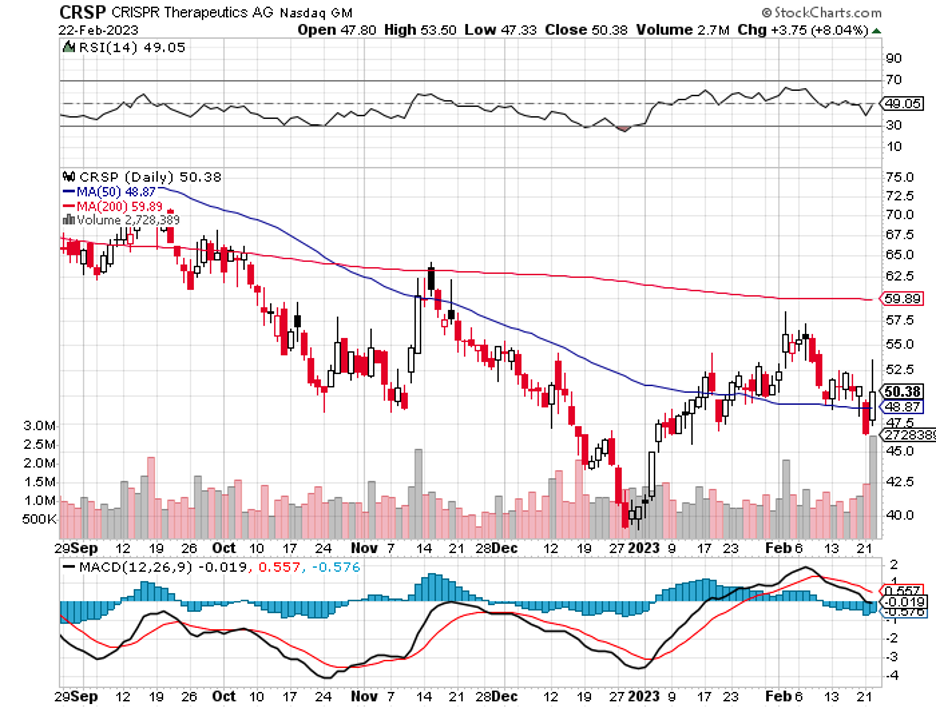
Global Market Comments
February 22, 2023
Fiat Lux
Featured Trade:
(TESTIMONIAL),
(TEN MORE TRENDS TO BET THE RANCH ON),
(AAPL), (AMZN), (GOOGL), (TSLA), (CRSP), (EDIT), (NTLA)

CLICK HERE to download today's position sheet.
Legal Disclaimer
There is a very high degree of risk involved in trading. Past results are not indicative of future returns. MadHedgeFundTrader.com and all individuals affiliated with this site assume no responsibilities for your trading and investment results. The indicators, strategies, columns, articles and all other features are for educational purposes only and should not be construed as investment advice. Information for futures trading observations are obtained from sources believed to be reliable, but we do not warrant its completeness or accuracy, or warrant any results from the use of the information. Your use of the trading observations is entirely at your own risk and it is your sole responsibility to evaluate the accuracy, completeness and usefulness of the information. You must assess the risk of any trade with your broker and make your own independent decisions regarding any securities mentioned herein. Affiliates of MadHedgeFundTrader.com may have a position or effect transactions in the securities described herein (or options thereon) and/or otherwise employ trading strategies that may be consistent or inconsistent with the provided strategies.
This site uses cookies. By continuing to browse the site, you are agreeing to our use of cookies.
OKLearn moreWe may request cookies to be set on your device. We use cookies to let us know when you visit our websites, how you interact with us, to enrich your user experience, and to customize your relationship with our website.
Click on the different category headings to find out more. You can also change some of your preferences. Note that blocking some types of cookies may impact your experience on our websites and the services we are able to offer.
These cookies are strictly necessary to provide you with services available through our website and to use some of its features.
Because these cookies are strictly necessary to deliver the website, refuseing them will have impact how our site functions. You always can block or delete cookies by changing your browser settings and force blocking all cookies on this website. But this will always prompt you to accept/refuse cookies when revisiting our site.
We fully respect if you want to refuse cookies but to avoid asking you again and again kindly allow us to store a cookie for that. You are free to opt out any time or opt in for other cookies to get a better experience. If you refuse cookies we will remove all set cookies in our domain.
We provide you with a list of stored cookies on your computer in our domain so you can check what we stored. Due to security reasons we are not able to show or modify cookies from other domains. You can check these in your browser security settings.
These cookies collect information that is used either in aggregate form to help us understand how our website is being used or how effective our marketing campaigns are, or to help us customize our website and application for you in order to enhance your experience.
If you do not want that we track your visist to our site you can disable tracking in your browser here:
We also use different external services like Google Webfonts, Google Maps, and external Video providers. Since these providers may collect personal data like your IP address we allow you to block them here. Please be aware that this might heavily reduce the functionality and appearance of our site. Changes will take effect once you reload the page.
Google Webfont Settings:
Google Map Settings:
Vimeo and Youtube video embeds:
